
It’s been a long time since anyone achieved what Donald Trump is trying to do in 2024. In fact, only one former US president has ever been re-elected – back in 1892, when anti-corruption crusader Grover Cleveland beat incumbent president Benjamin Harrison, a great-grandson of one of the country’s “founding fathers”.
Not only for that reason does this year’s US presidential campaign promise to be one for the ages. It’s also likely to end up as the first duel between two presidents since 1912, when Theodore Roosevelt threw his hat into the ring for the Progressive Party against then sitting president Republican William Howard Taft. Both lost to Woodrow Wilson, the Democrat challenger. (Herbert Hoover, who was in the top job from 1929 to 1933, tried it on in 1940 but failed to win the Republican nomination.)
And while Joe Biden is all but assured of his party’s support for a second term – setting a record for the oldest-ever US president if he wins, aged 81 – the Republicans may be in for a wild ride. Trump has already disposed of his rivals. Yet still hanging over him is the possibility of an unlikely twist: given the raft of criminal charges he faces, he could plausibly win the nomination and the presidency and have to serve his term from the inside of a jail cell.
What is a primary, anyway? Why is the process, which lasts some seven months, so convoluted, confusing and downright quirky?
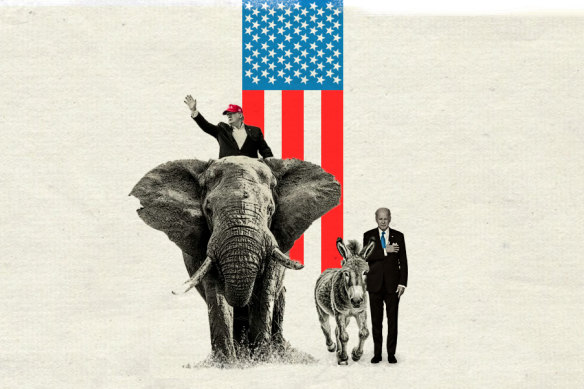
Trump and Biden are the most likely presidential adversaries for 2024. Credit: Artwork Stephen Kiprillis, Matthew Absalom-Wong
How do the primaries work?
“Many things about America can be understood as the downstream consequence of a really peculiar presidential nominating system,” says Zim Nwokora, a senior lecturer in politics and policy studies at Deakin University. “To my mind, it’s absolutely at the heart of why American politics works as it does.”
There is surprisingly little in the US Constitution that speaks to how candidates should be chosen – so exactly how the process runs each year can be a bit of a moveable feast. Until the 1970s, party bosses in smoky back rooms held much of the sway. “They sometimes had primaries but they were no more than illustrative,” says Nwokora. “They gave the elites information about how the people in their state thought but they weren’t binding in any meaningful sense.”
That largely changed after the chaotic Democratic National Convention of 1968, which saw police clash with protesters including students opposing the Vietnam War. Hubert Humphrey was chosen as the party’s presidential candidate despite not having won a single primary contest (and went on to lose the general election, to Richard Nixon). After the Democrats reviewed the process, much more power flowed to the rank and file and the Republicans subsequently followed suit, albeit in their own way.
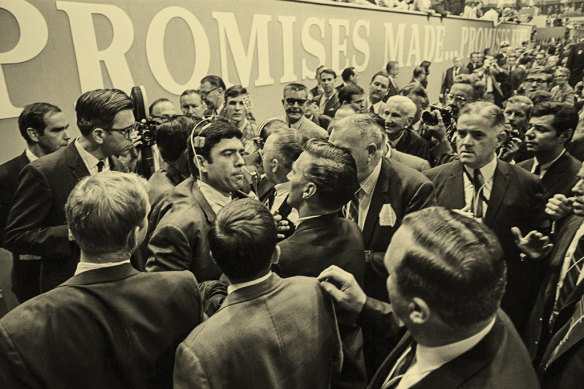
Reporter Dan Rather is surrounded by security guards after he tried to question someone being escorted out of the famously volatile Democratic National Convention of 1968 in Chicago.Credit: Getty Images
To best understand the primaries it’s easiest to begin at the end – when both the Democrats and Republicans officially nominate their presidential candidates. This occurs every four years at vast national conventions, where thousands of party faithful called delegates – plucked from the ranks of local party members, loyal campaign workers and the like – gather to vote for their preferred candidate. This year, the Republicans will hold their convention from July 15 to 18 at a basketball arena in Milwaukee, Wisconsin; the Democrats from August 19 to 22 in another arena in Chicago, Illinois.
Delegates are divided into two main groups: most are “pledged” or “bound” to represent the wishes of voters from their party in their home state, the rest are not (they can vote for whoever they choose at the convention). There are some 157 unpledged – or unbound – delegates for the Republicans and 738 for the Democrats, including former presidents. These folk, however, only really play a role at the convention if the race is still too close to call and their votes can make a difference.
Of pledged delegates, there are an estimated 3936 for the Democrats, 2272 for the Republicans, according to election tracker The Green Papers. The states all have varying numbers of these delegates, based on population: Nevada, for example, has just 36 Democrat-bound pledged delegates while California (on March 5, Super Tuesday) has a bountiful 424 up for grabs. And within the framework of national party rules, each state has its own – slightly varying – methods to determine how many of their parties’ raft of delegates will ultimately support each candidate at the convention, finally determining – at last – who will represent their party in the presidential election.
This is where the primaries come in: statewide elections held either as conventional ballots run by state authorities, or the less common caucuses run by the parties themselves, where party members gather in places such as school halls to argue about which candidate they should support, sometimes voting with a show of hands.
Caucusing remains “an interesting process”, says Thomas Adams, a professor at the University of South Alabama who also teaches at the University of Sydney. “You’ve got people who are willing to take an hour to two hours on a really cold Monday night and come out and spend some time and try to convince their neighbours and their friends and people in their community to support their candidate.”
Most of the ballots take place in primaries, which vary slightly state to state in how voting works. In some states’ primaries you can largely vote for the candidate you want, irrespective of your party allegiance. In others, you must be a registered party member and can take only that party’s ballot paper. And while some states allow early mail-in votes, some require an in-person appearance. The Democrats allocate candidates a number of delegates that corresponds to their proportion of the vote. The Republicans can use a mix of proportional allocation and winner-takes-all, which can accelerate a leading candidate beyond reach of their rivals.
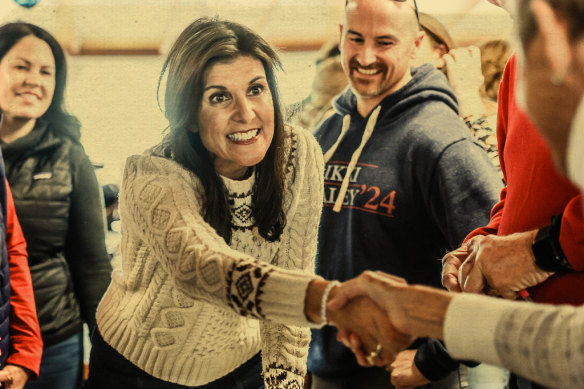
Republican Nikki Haley in New Hampshire shortly after Ron DeSantis dropped out of the race.Credit: Getty Images, digitally altered
Either way, your vote determines how many delegates the surviving candidates will eventually be awarded going into the national conventions. New Hampshire, for one, holds an “open” primary, meaning both registered party members and non-aligned voters can participate in the same ballot.
Some states, meanwhile, hold both parties’ contests on the same day and some don’t. Some choose to run the ballot on the same date as other states and territories (such as the 16 on Super Tuesday). But many don’t do either, necessitating a drawn-out affair that demands the candidates campaign in as many of the 50 states as they can, flying in and out for personal appearances. (US territories such as the Virgin Islands, Guam and the Northern Mariana Islands also play a role but cough up only a handful of delegates.)
‘It’s a really gruelling race that goes on for months and months where they have to appeal to many different groups of people, having to shape-shift depending on where they are in the country.’
It can be exhausting and extremely expensive – two factors that usually lead to most candidates withdrawing long before the primaries are complete. NPR estimated that by mid-January the Republican candidates alone had already spent some $450 million in advertising. Nikki Haley revealed she would spend $6 million on advertising just in her home state of South Carolina, where she was governor from 2011 until 2017.
Look at it as survival of the fittest, says Deakin University’s Zim Nwokora. “Putting them through the gauntlet is probably quite a good way of seeing what they’re made of,” he says. “It’s a really gruelling race that goes on for months and months where they have to appeal to many different groups of people, having to shape-shift depending on where they are in the country. The candidates who can get through that are normally pretty hardy.”
It’s a much smoother road for Joe Biden. No sitting president has lost a primary nomination in modern US history. For Biden, the primaries are about setting his party’s agenda and already campaigning for the presidency. His opponents, Marianne Williamson, a self-help author and former spiritual adviser to Oprah Winfrey, and Minnesotan Dean Phillips, are most likely running to raise their personal profiles or have plans for a future tilt at the presidency.
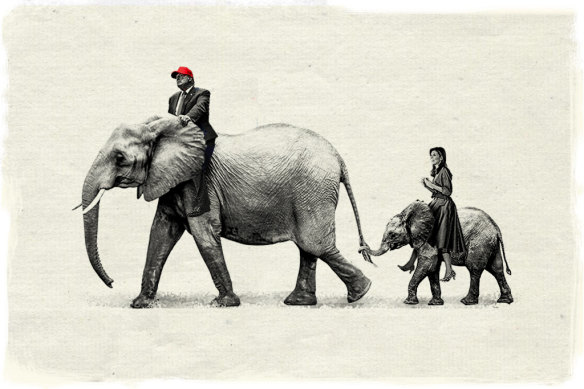
The Republican candidacy is now a two-way race. Credit: Artwork Matthew Absalom-Wong
What’s Super Tuesday?
Falling this year on March 5, Super Tuesday is the informal name for the day when the most states hold their primaries or caucuses on the same date. This year, it involved 15 states and one territory: Alabama, Alaska, Arkansas, California, Colorado, Maine, Massachusetts, Minnesota, North Carolina, Oklahoma, Tennessee, Texas, Utah, Vermont, Virginia and the territory of American Samoa.
Super Tuesday became cemented in tradition in the late 1980s when a group of Democrats figured out that if they held their ballots on the same day across several states they might be able to influence who the party eventually chose as their presidential candidate. The theory remains the same today. By forcing candidates to campaign hard across several states simultaneously, it offers one the chance to leap ahead in the race (or, in Nikki Haley’s case, to fall irretrievably behind).
This year, over a third of Republican delegates were up for grabs on Super Tuesday, with a similar number for the Democrats.
While the result was of little consequence for President Joe Biden, who is expected to be nominated with no contest, Super Tuesday was Haley’s last stand and the day Donald Trump could effectively seal his nomination – although it will be another fortnight or so – and a few more primaries, before he can officially hoover up the 1215 delegates he needs to guarantee a majority at the convention. On March 18, there are ballots in Arizona, Florida and Ohio, which deliver many delegates and will push him over the line.
In the event, Super Tuesday played out as expected: Trump swept through most states easily, including delegate-rich Texas and California, with Haley putting up a fight only in Vermont, a victory The New York Times dubbed “elusive and seemingly inconsequential”. As expected, she subsequently dropped out of the race.
Why was Iowa such a big deal?
Iowa was first cab off the rank this year - as it has been since 1972, when it hosted that year’s Democratic caucus (the Republicans followed four years later). Despite delivering only a handful of delegates (40 Republican, 46 Democrat), it receives outsized attention from candidates and media alike, reflecting the role that tradition, custom and pageantry exert on US politics. Which is why contender Ron DeSantis basically went all-in on Iowa with his campaign effort, only to land a distant second to Trump and bowing out.
Even early in the process, it’s all about the money, says Bruce Wolpe, a Colorado native and a senior fellow at the United States Study Centre at the University of Sydney. “DeSantis attracted backers with tens of millions of dollars but what do they have to show for it? Nothing.”
If you win in Iowa it’s supposed to be a good omen for the rest of the campaign. This is partially true: the-then little-known former governor Jimmy Carter went on to become president after winning Iowa in 1976. Yet Trump also won Iowa in 2020 (virtually unopposed as befitted an incumbent president) and lost the presidency. And the three Iowa primaries before that were just as unlucky for Republican winners: Ted Cruz (2016), abortion-opposing Rick Santorum (2012) and Mike Huckabee (2008) all triumphed yet failed to ultimately capture their party’s nomination. In contrast, Joe Biden came a miserable fourth in Iowa in 2020 for the Democrats but went on to win the highest office in the land after coming back strongly in later states; Bill Clinton did the same after he also lost Iowa in 1992.
Nevertheless, Iowa clearly exerts some kind of voodoo. Biden made sure he wouldn’t have a poor showing in Iowa this time by going so far as to change his party’s rules to delay the result, which would likely be a shoo-in anyway. (Instead of a one-day caucus, Democrats mailed in what they call an “expression of presidential preference”, the results of which will not be made public until March 5, buried amid the rest of the Super Tuesday returns.)
But why is it always Iowa that starts the campaign rolling? First, it is state law. Second, Iowa employs a particularly complicated process requiring the parties to hold multiple conventions before the delegate count is decided. This takes months. (When you read that Donald Trump received 20 delegates at the Iowa caucuses, that’s currently still an estimate.)
“That is such a dog’s breakfast that the media never report it,” says John Hart, a former head of department at ANU and author of The Presidential Branch: From Washington to Clinton. “They just assume that the results from the Iowa precinct caucuses will be reflected all the way through and the candidates will get the number of delegates at the national convention that they got in the precinct caucuses.
“The problem is, of course, that some of those candidates won’t be in the race when the Republicans hold their convention in July.”
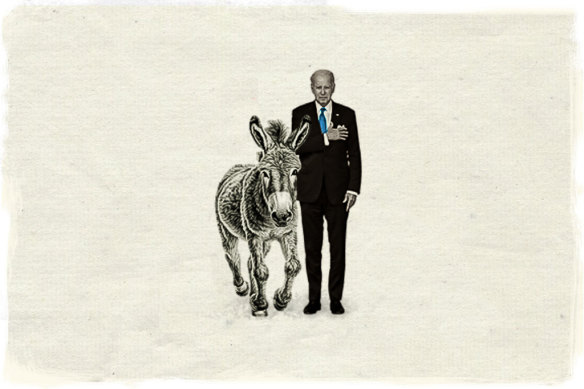
As the incumbent president, Joe Biden should have a relatively smooth ride through to the national convention. Credit: Artwork Stephen Kiprillis, Matthew Absalom-Wong
What was so unusual about New Hampshire – and Nevada?
The first primary (remember, Iowa is a caucus), New Hampshire was of vital importance to the Republicans, who by then were already running a two-way contest between Trump and Nikki Haley. For Haley, a good showing was critical both to boost momentum among her supporters and to encourage her donors to stay the course.
At least one of Haley’s billionaire financial backers was hanging on the result, according to the Financial Times, which reported that Ken Langone, co-founder of US retail chain Home Depot, said he was prepared to give Haley “a nice sum of money” but “[i]f she doesn’t get traction in New Hampshire, you don’t throw money down a rathole.”
In the event, she came second to Trump, who will be awarded most of the 22 delegates up for grabs. An upbeat Haley vowed to continue the campaign. However, as The New York Times noted, no Republican candidate has ever won the first two states and not won the party’s presidential nomination.
For the Democrats, New Hampshire proved curly thanks to an internal party battle over the timing of the primary, which was only partly resolved. The national Democrats wanted it moved to later in the year so South Carolina – a more racially and economically diverse state that better represents the party’s support base – could host the first actual primary. But that would have required a change to New Hampshire legislation, which mandates it has to hold its primary before any other.
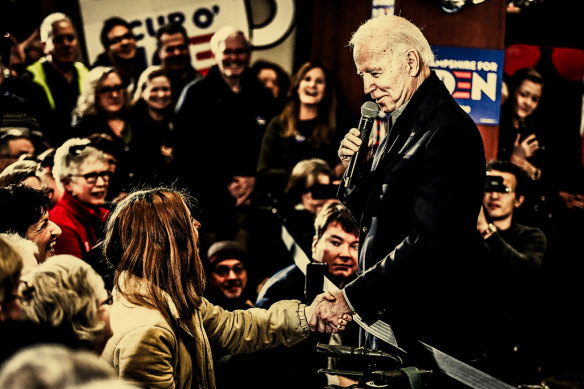
Joe Biden shakes hands with a voter in New Hampshire ahead of the state’s primaries in 2020.Credit: Getty Images, digitally altered
The result: the Democratic primary went ahead anyway, but Biden did not have his name on the ballot. In yet another twist, though, the rules allowed voters to fill in the name of anybody they wanted in a blank box on the ballot, called a “write-in” vote, and Biden won that way anyway.
It was Nevada, in February, where it truly got weird for the Republicans.
Before this year, both parties traditionally ran caucuses in Nevada. However, in 2020, after Democrat contender Pete Buttigieg alleged there were “irregularities” in the process, leading to a recount, Nevada’s government legislated that its contest should henceforth be run as primaries (which, remember, are conducted by the state government and not the party). The Republicans did not agree and decided to hold a caucus anyway in 2024. Moreover, they mandated that only the caucus results would be considered when delegates were awarded and – crucially – that if any Republican candidate did enter a primary they would be barred from also entering the caucus.
So it was somewhat baffling when Nikki Haley (and others) went ahead and entered a Republican primary anyway. That meant Haley was guaranteed exactly zero of Nevada’s 26 Republican delegates. Why did Haley choose the primary? She wasn’t saying. One theory was she hoped a solid win in the dead-rubber contest would boost her profile and renew her momentum going into South Carolina (which she lost anyway).
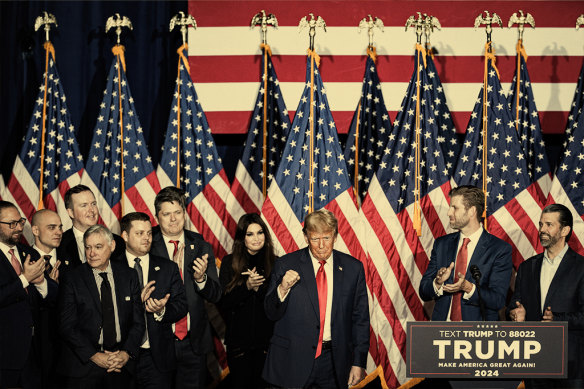
Trump speaks at a caucus-night party in Iowa on January 15.Credit: Getty Images, digitally altered
What happened with Colorado and Trump?
Of particular interest on Super Tuesday was Colorado, whose Supreme Court had ruled that Trump was ineligible to stand due to charges of insurrection.
The Colorado case hinged on three key questions. First, whether it was an insurrection when Trump supporters stormed the Capitol (the seat of Congress) in Washington, DC, on January 6, 2021, following a rally at which Trump repeated false claims that the election held in November 2020 had been fraudulently stolen from him.
Second, whether Trump had engaged in that insurrection through his messages to supporters and his Twitter posts.
Third, and crucially, whether Section 3 of the 14th Amendment, adopted after the US Civil War and rarely mentioned since, specifically applied to the presidency.
The court in Colorado answered yes to all three and barred Trump from that state’s ballot. However, it stayed its decision to allow the national Supreme Court to hear Trump’s appeal, allowing Trump to still appear on the ballot until a decision was made. Ultimately, the highest court in the land unanimously cleared Trump to run.
‘I don’t think the Republican Party will be stupid enough to nominate Trump as a candidate if they know he’s barred from becoming president.’
Loading
But then there’s the other problem. Trump has been criminally indicted in four separate cases with multiple felony charges. If convicted, he could be sent to prison. Would that prevent him from becoming president? Not at all. Such an outcome would put him in the company of Eugene Debs, imprisoned as a “radical” and who unsuccessfully ran for president from jail in 1920 and conspiracy theorist Lyndon LaRouche who in 1992, while serving a 15-year sentence for mail fraud and campaign fraud conspiracy, somehow still managed to receive over 26,000 votes.
The Constitution lists only three qualifications for the presidency. The president must be at least 35 years of age, be a natural-born citizen (someone who was a US citizen at birth and did not need to be naturalised later in life) and must have lived in the US for at least 14 years. Trump meets these criteria. Should he win the presidency, he could hold office behind bars or pardon himself. As John Hart says, this has all “the makings of a good novel”.
This article has been updated since it was first published on January 23.
Get fascinating insights and explanations on the world’s most perplexing topics. Sign up for our weekly Explainer newsletter.









 Add Category
Add Category